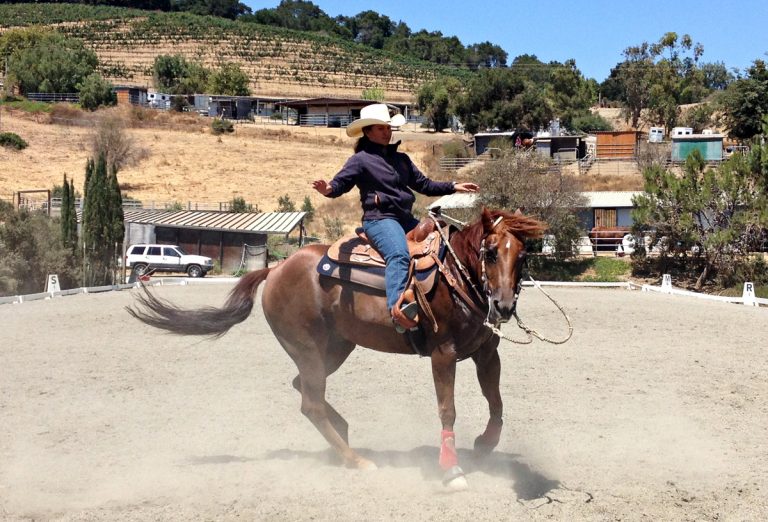We are pleased to feature our first guest blogger, trainer and CHA Master Instructor Serena Heppes. Serena is the trainer at Under The Son Horsemanship located in Los Gatos and Saratoga, CA. Her training program focuses on developing versatile horses and riders with a solid horsemanship foundation. She has experience in quite a few disciplines having double majored in Combined Training and Reining/Cutting from Canyonview Equestrian College. She has experience in Dressage, hunter/jumpers, 3 day, English/Western pleasure, reining, and cutting and puts all of that knowledge to good use in training well rounded riders and horses. We love what Serena has to say about the training (and retraining) of horses and appreciate her taking the time to write something for us. You can get more information on her website or visit her on Facebook.
Big thanks to J. Biggs for photographs 2 and 4 in the slide show.
Have you ever painted something? What about painting over something existing, like a table just to make it look nice? Imagine completing a painting that someone else started, without seeing what the finished product is supposed to look like. This is what it’s like to work with a horse that has had training with someone else. As a trainer I have had my fair share of working with problem horses. It is important to think about what the horse has done in the past. Does it have good ground work? Is it supple? The list goes on and on.
This past year one of my students purchased a horse out of the area so I drove out to go pick it up. The trainer who was making the sale said that she would ride him for us so I could better understand him. After watching her ride, I could tell that there were already a few problems. There was nothing soft about the horse or the rider. The strides were short and choppy, his back was hollow, and his head and neck were clenched shut. I knew from that moment that he would be a project for us. As we started to ride him and ask him to stretch long and low, engaging the back and becoming more supple, we came to realize that it was more than just stiffness in the horse. There was no foundation in his training at all. To use the painting analogy, the canvas was never put on the stretchers correctly. Having to go back to the pure basics is what we have to do when a horse and rider is having a problem. Take it back to the foundational elements.
Young horses are ideal for the experienced rider in the sense that they are a blank canvas. You have the largest ability for impact, however, because the canvas is so blank, there is more room for error which can cause a problem in your finished result. In this same way, a young horse can pick up a habit which could be difficult to correct. The great George Morris said “Every second you’re either schooling or un-schooling your horse. There is no in between.” This is why people send their young horses to trainers, to get set up with consistency on the ground and under saddle. We have been taught how to find a good habit, teach it, and keep it on a horse. Some horses it may take a while to un-school than others. Older horses have less of a blank canvas to work on. Their paintings are close to being complete. The younger the horse, the more potential outcomes (good or bad) there are.
It is not just in riding that we can affect a horse’s training. Horses learn with any type of handling. I had a student who audited a Buck Brannaman clinic and said that Buck had handed his horse to someone in the clinic and said “don’t ruin it while I’m gone.” Everyone laughed at the joke but unfortunately it’s completely true. I can tell when horses have been handled by someone else. Whether it’s one of my students, a farrier, or someone that’s experienced at my barn, the horse will change its behavior. One of the horses I have in full training is a child’s mount. Surprisingly, she’s the one in the barn with the toughest ground manners. Because she is handled by a child, she has learned that she can get away with certain things. She has gotten away with it so many times and will then test you every time when you work with her. Now we must assert ourselves every time we handle her. She’s a pushy bully on the ground and it can transfer under saddle as well. Someone who allows a horse’s attention to drift away from them allows that horse to mentally disengage. This lets that horse think that it is okay to do that on the ground, in the saddle, in the round pen or anywhere. Riding a horse and picking up contact, but not asking them to give correctly, or a rider not giving at the bit correctly translates into inconsistency to the horse. This in turn ruins part of the horse’s training.
Keep in mind that when you’re working with a trainer that they are painting a masterpiece for you. Not only do they want to finish this masterpiece, they need the owner to understand it and contribute to the final product. Every time you ride a horse that is in training, the trainer gives you the tools and knowledge to help with the final painting. Every session you have with a horse either damages or builds upon their training. Sometimes you may need to go back to the basics, fix the canvas, and then continue to create your masterpiece. Talk to your trainer, pick up that paintbrush, and ride on!
Thank you Serena! Remember to visit her on her website and Facebook.

